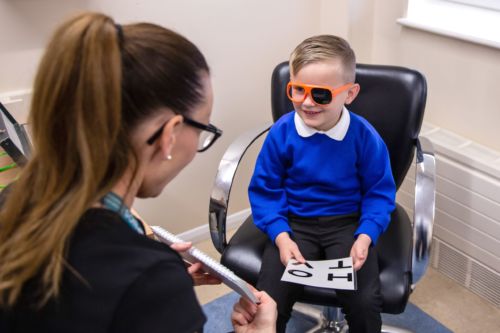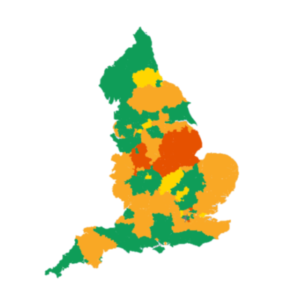Children’s Vision Screening
Vision screening of children is a designed to detect reduced vision in one or both eyes. It is a straightforward and entirely safe test, and should be carried out at 4-5 years of age so that, if required, your child can receive treatment at an age when it is most effective. Vision screening is usually carried out in school (England, Wales, NI and Republic of Ireland) or pre-school in Scotland.
Why is vision screening necessary?
Vision screening is carried out to detect Amblyopia, which is more commonly known as a “lazy eye”. Amblyopia is when the vision in one or both eyes doesn’t develop properly. It is estimated that 1 in 50 children will develop this condition.
Children are usually unaware that their vision is weaker than normal in one or both eyes. There are often no visible signs so problems can easily go unnoticed, especially when it only affects one eye.
The most common causes of amblyopia are refractive error (the need for glasses) and strabismus (a squint, turn of the eye). If amblyopia is left undetected it can result in permanent reduced vision.
It is recommended by the UK national screening committee (UKNSC) that standardised vision screening, organised and led by orthoptists, should be offered to all children aged 4-5 years. This means that every child can be given the opportunity to have their vision tested without the onus being put on to parents to take their children for an assessment, this is especially important for those children who are vulnerable or at risk.
Who does the screening?
In most cases, your child’s vision will be assessed by either an orthoptist, or a healthcare worker trained by an orthoptist.
Orthoptists are allied health professionals that are specialists in testing vision and detecting visual problems, particularly in children. They are therefore ideally qualified to deliver or lead vision screening;
- Amblyopia is most commonly caused by refractive error leading to a lack of focus within one or both eyes, or strabismus, where the two eyes are not aligned.
- Orthoptists are experts in the assessment of visual defects in young children.
- Orthoptists are uniquely qualified to offer services for children with learning disabilities or with specific needs who require an alternative method of testing.
In Scotland, Wales and Northern Ireland, all children are assessed as part of a mandatory orthoptic-led vision screening service. In England vision screening is recommended but not all local authorities provide a vision screening service. BIOS are calling for a mandatory national screening programme in England.
You can read about our campaign for a National screening programme in England here and check if your local authority is already providing vision screening on our interactive map.
Why at 4-5 years?
Amblyopia can be treated successfully in younger children, therefore early detection and treatment with glasses, eye patches or both can be started. Treatment for amblyopia has been shown to be less successful beyond approximately eight years of age.
Testing at 4-5 years allows vision tests to be carried out that are accurate enough to detect real problems, whilst minimising the number of children referred for further testing unnecessarily. Additionally, testing in a familiar environment such as school or nursery improves confidence and ability to cooperate. This also enables screening to be consistently delivered to almost all children in the country.
What will the screening test involve?
The screening test is non-invasive, takes only a few minutes and is a fun experience for children.
The orthoptist or vision screener will assess your child’s vision using a letter naming game, or a matching game, if they are not confident with the alphabet. One eye will be covered either with glasses with a lens blanked out, or with a patch to ensure your child can see normally with each eye.

The helpful leaflet for parents, downloadable here from NHS England, provides more information on vision screening in England.
In Scotland, there is a series of helpful web pages on the See4School pre-school screening programme.
What happens next?
If screening suggests that your child has reduced vision, they will be referred for further assessment. This could be to community or hospital eye service or to an optometrist at your local high street opticians. They will be able to recommend the most appropriate treatment for your child.
After vision screening
If your child complains of any problems with their eyes after their screening assessment we recommend you take your child to any high street optometrist or your GP.
Further information can be found at https://www.nhs.uk/conditions/eye-tests-in-children/
